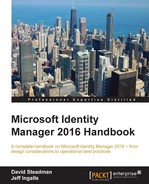Microsoft Identity Management (MIM)—certificate management (CM)—is deemed the outcast in many discussions. We are here to tell you that this is not the case. We see many scenarios where CM makes the management of user-based certificates possible and improved. If you are currently using FIM certificate management or considering a new certificate management deployment with MIM, we think you will find that CM is a component to consider.
CM is not a requirement for using smart cards, but it adds a lot of functionality and security to the process of managing the complete life cycle of your smart cards and software-based certificates in a single forest or multiforest scenario.
In this chapter, we will look at the following topics:
- What is CM?
- Certificate management components
- Certificate management agents
- The certificate management permission model
Certificate management extends MIM functionality by adding management policy to a driven workflow that enables the complete life cycle of initial enrollment, duplication, and the revocation of user-based certificates. Some smart card features include offline unblocking, duplicating cards, and recovering a certificate from a lost card.
The concept of this policy is driven by a profile template within the CM application. Profile templates are stored in Active Directory, which means the application already has a built-in redundancy. CM is based on the idea that the product will proxy, or be the middle man, to make a request to and get one from CA. CM performs its functions with user agents that encrypt and decrypt its communications.
When discussing PKI (Public Key Infrastructure) and smart cards, you usually need to have some discussion about the level of assurance you would like for the identities secured by your PKI. For basic insight on PKI and assurance, take a look at http://bit.ly/CorePKI.
In typical scenarios, many PKI designers argue that you should use Hardware Security Module (HSM) to secure your PKI in order to get the assurance level to use smart cards. Our personal opinion is that HSMs are great if you need high assurance on your PKI, but smart cards increase your security even if your PKI has medium or low assurance. Using MIM CM with HSM will not be covered in this book, but if you take a look at http://bit.ly/CMandLunSA, you will find some guidelines on how to use MIM CM and HSM Luna SA.
The Financial Company has a low-assurance PKI with only one enterprise root CA issuing the certificates. The Financial Company does not use a HSM with their PKI or their MIM CM. If you are running a medium- or high-assurance PKI within your company, policies on how to issue smart cards may differ from the example. More details on PKI design can be found at http://bit.ly/PKIDesign.
